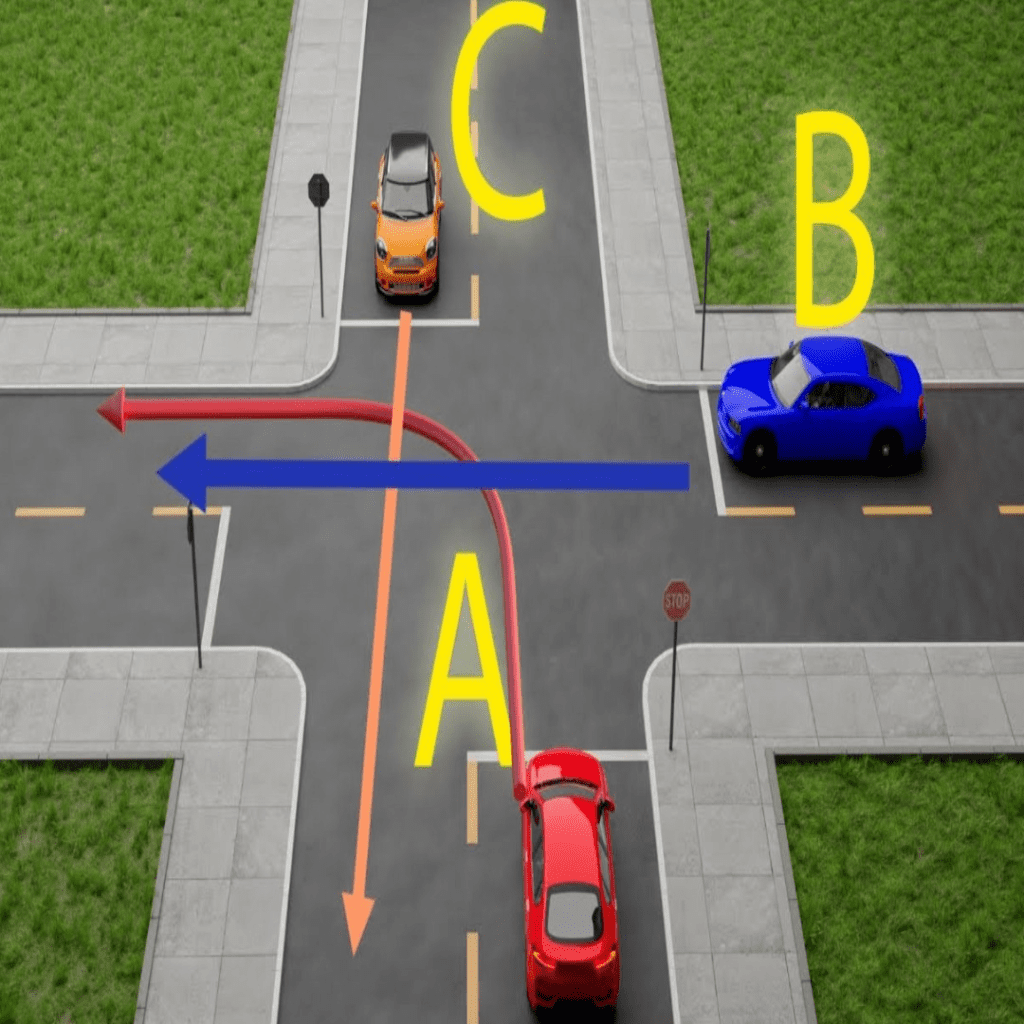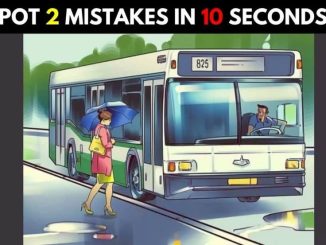When approaching an intersection, understanding which car has the right of way can be quite challenging. Traffic rules can be confusing, especially when multiple vehicles arrive at the same time. The image above is a perfect example of a scenario that can baffle even experienced drivers. So, which car has the right of way? Let’s analyze the situation and find the correct answer.
The Challenge: Who Goes First?
The image shows an intersection where three cars (A, B, and C) are arriving from different directions:
- Car A (Red) is approaching from the bottom and plans to turn left.
- Car B (Blue) is coming from the right and intends to go straight.
- Car C (Orange) is moving downwards and intends to continue straight.

At first glance, it’s not entirely clear which car should move first. This puzzle challenges your understanding of traffic rules and right-of-way regulations. Take a moment to think: who do you think has the priority here?
Common Mistakes People Make
When faced with this intersection puzzle, many people tend to make a few common errors. Here’s why they often get it wrong:
- Assuming First Come, First Serve: Many assume that the car that arrived first should go first, which isn’t always true in regulated intersections.
- Overlooking Traffic Signs: Some people don’t notice the stop sign for Car A, which is a crucial detail.
- Misinterpreting Right of Way Rules: Others believe that since Car A wants to turn left, it should yield to both straight-moving cars, but that’s not the complete picture.
- Neglecting the Direction of Travel: Some fail to consider that cars moving straight often have priority over turning vehicles.
By not paying attention to all the visual cues and traffic regulations, many end up choosing the wrong answer. Now, let’s break down the puzzle step by step to find the correct solution.
Step-by-Step Solution: Understanding the Right of Way
Step 1: Observe the Traffic Signs
The first thing you should notice is the stop sign placed in front of Car A. This means that Car A must come to a complete stop and give way to other vehicles that do not have a stop sign. This instantly tells us that Car A will not move first.
Video : which car has the right of way?
Step 2: Analyze Car B’s Movement
Car B intends to go straight and has no stop sign. In most traffic regulations, cars moving straight have priority over turning vehicles. However, Car B also needs to consider vehicles already on the intersection road.
Step 3: Understand Car C’s Position
Car C, coming from the top and moving straight, also has no stop sign. Since it is moving straight and is already on the road that Car B intends to enter, Car B must yield to Car C according to traffic rules.
Step 4: Determine the Priority
The priority order is based on the following logic:
- Car C has the right of way since it is moving straight and has no stop sign.
- Car B will move next after Car C because it is also moving straight and has no stop sign.
- Car A must wait until both Car B and Car C have cleared the intersection due to its stop sign and left-turn intention.
Final Answer: Car C Has the Right of Way
Car C moves first, followed by Car B, and finally Car A. This order ensures that vehicles moving straight with no stop sign proceed before any car making a left turn, especially if that car has a stop sign.

Why It’s Easy to Get Confused
Many drivers make mistakes in situations like this because they rely on intuition rather than clearly analyzing the situation. They might think that the car on the right always goes first or that arriving earlier gives priority. However, intersection rules prioritize straight-moving cars and give precedence to those without a stop sign.
Important Traffic Rules to Remember
- Yield to the Right: If two vehicles arrive at the same time, the car on the right generally has the right of way.
- Stop Sign Rules: Cars at stop signs must yield to all other traffic not facing a stop sign.
- Straight Before Turning: Cars moving straight always have the right of way over cars turning left.
- Observe All Signs: Always consider traffic signs before making a decision at intersections.
Why Traffic Puzzles Are Important
Understanding traffic rules through puzzles helps reinforce road safety knowledge. Intersections can be dangerous if drivers aren’t clear about the rules, and practicing these scenarios helps build quick decision-making skills. Such puzzles not only test your knowledge but also prepare you for real-life situations on the road.
Encourage Engagement: Your Turn!
Did you guess the correct answer before reading the explanation? Share your thoughts in the comments below! Did the logic make sense to you, or did the puzzle trick you at first? We’d love to know how you approached the problem.
Video : Which car is right with its owner!!
Try More Traffic Puzzles!
If you enjoyed this challenge, why not try more traffic-related brain teasers? Improving your understanding of road rules can make you a more confident and cautious driver. Stay curious, stay engaged, and never stop learning!
Conclusion: Safety First
Traffic puzzles like this one highlight the importance of knowing and following road rules. Misinterpretations can lead to accidents, so being clear on who has the right of way is crucial. In real life, make sure to assess all signs and signals carefully before proceeding through intersections.
Remember, safety always comes first, and a little bit of critical thinking can go a long way in keeping you and others safe on the road. Stay safe, and keep practicing with more puzzles to sharpen your logic and observation skills!


